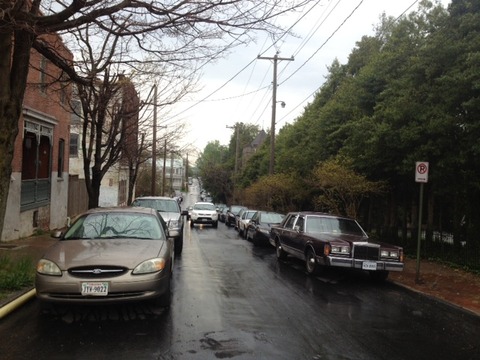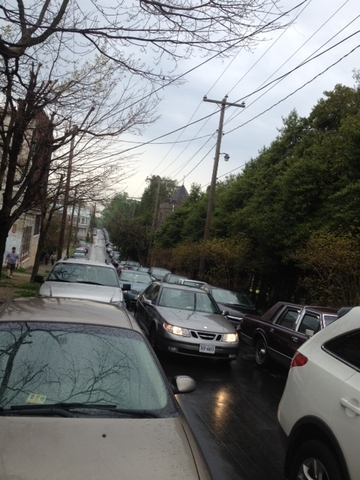From email:
Ms. Lory Markham
Planning Department
City of Richmond
June 27, 2012Dear Ms. Markham,
The Oregon Hill Neighborhood Association (OHNA) received the revised application for the Victory Apartments Special Use Permit (SUP) for 407 S.Cherry Street and 811 Albemarle Street. Because the applicant has failed to address the neighborhood’s concerns about the density of the project and the lack of appropriate parking, OHNA urges the City staff and Planning Commission to recommend against approval of the revised plan.
In our correspondence dated April 25, 2012, in response to the original SUP application, OHNA urged the applicant to lower the density of the number of apartment units proposed for the Victory Rug building in line with the four to six units that are acceptable under the current zoning of the property. The original application proposed 18 apartment units, but the current revised application proposes 18 apartment units along with a single family dwelling. Instead of reducing the density, the applicant has actually increased the density of the project in the revised SUP, showing a disregard for the concerns of the neighborhood.
In our earlier correspondence, OHNA also pointed out that the applicant had an inadequate number of parking spaces and that the few parking spaces that he proposed were not functional. The original application proposed 18 parking spaces, but the current revised application proposes 8 parking spaces for a project with a higher density. Instead of increasing the number of parking spaces, the applicant has actually reduced by ten the number of proposed parking spaces, again showing a disregard for our neighborhood concerns.
Indeed, none of the eight parking spaces proposed in the revised SUP appear to be functional, according to the guidelines of City Ordinance Section 114-710.3:1. Dimensions of Parking Spaces. According to the ordinance, a 25 foot aisle is required for 90 degree parking spaces, with a width of 8 feet, for full sized cars. Two alleys provide the aisle space for all of the proposed parking spaces. Five of the parking spaces spaces have an aisle of 20 feet provided by the 20 foot wide alley running in the north/south direction. Three of the parking spaces have an aisle of about 10 feet provided by the 10 foot wide alley running in the east/west direction. Without the required 25 foot aisle width, there is not enough turning radius to safely maneuver into these parking spaces. Also, backing from the parking spaces into the two alleys would be precarious because of the blind corners resulting from the building at 809 Albemarle Street, the trash enclosure, and a fence. Furthermore, the parking space beside 809 Albemarle Street, a contributing structure to the Oregon Hill Historic District, must be removed if the applicant intends to apply for state and federal historic tax credits; parking cars next to historic structures is not recommended by the National Park standards.
OHNA objects to on-street parking being used to support the parking requirements for this project. The 400 block of Cherry Street is too narrow to support parking on both sides of the street. At the location of the Victory Rug building, the street is only 25′-9″ wide. The street continues to narrow as it approaches the top of the hill, where the street is only 23′-3″ wide. This width is well below the 28′ standard width for residential streets with parking on both sides of the street. It would present a serious safety concern if cars are parked on both sides of the street, because fire trucks and other emergency vehicles would be unable to travel in that block.
In response to the original SUP application, the city commented that it recommended that the applicant have one parking space per bedroom. The original application had inadequate parking with approximately one parking space for every two-and-a half bedrooms. With the revised SUP, the applicant has far fewer parking spaces along with additional bedrooms, equal to about one parking space for every four bedrooms. While we are pleased that the applicant has eliminated the primary use of the lot at 811 Albemarle Street in the R-7 zoning for parking and has eliminated the proposed curb cut from Albemarle Street onto this lot, this does not relieve the applicant from the burden of providing the necessary parking for the project.
OHNA is not impressed with the spec housing unit that is proposed for the lot at 811 Albemarle Street. The house appears to be designed with materials and trim details, such as vinyl siding and composition shingles, that are inferior to the average Oregon Hill dwelling.
Our association has made it clear that we do not want these apartments to be rented to VCU students. So the neighborhood was particularly dismayed to read in the application that “All sidewalks to be brick to match adjacent VCU construction …”
OHNA has made a sincere effort to work with the developer on this project. We have suggested that renting the units to the elderly would relieve approximately half of the parking requirement while alleviating the neighborhood’s concern that the units will be rented to students. We have suggested that larger units would be more easily converted to condominiums in the future and would require fewer parking spaces. Instead, the developer has chosen to disregard the community’s concerns and disregard the city’s parking and zoning requirements.
In the years preceding and including 2002, the City devoted much time and many resources toward developing an appropriate zoning designation for the Oregon Hill Historic District. The result was R7, a code that was focused primarily on single family housing and embraced wholeheartedly by a community and City Staff/Administration. OHNA considers itself open minded and flexible to reasonable new development within the neighborhood. We have collaborated with such past projects as The Overlook with Steve Middleton and continue to work to better the neighborhood with projects such as the former Synergeo building with developer Nolen Blackwood, proving our commitment to reasonable development.
All projects are judged on their individual circumstances for SUP support. Should a project merit exception, it must exhibit unique and exceptional resources to qualify for relief from certain relevant legal restrictions. For example, if a parcel has a great deal of private parking available or large area of land to accommodate extra density, then we would certainly consider that rationale in our decision. However, in the case of the Victory Apartments, the developer has not made his case for exception and, in fact, was advised by OHNA before closing on the property of the inherent limitations on developing this parcel, including what was acceptable by the community in terms of density and parking requirements.
We respectfully request that Victory LLC be limited to the existing laws and be restricted to the initial ruling of four to six units of two or three maximum bedrooms per unit for its multifamily development with the hope of future single family conversion. This is the appropriate approach and density for our neighborhood.
Again, we encourage the City staff and City Planning Commission to reject the revised SUP as submitted.
Thank you for your consideration.
Sincerely,
Jennifer Hancock
OHNA, President



